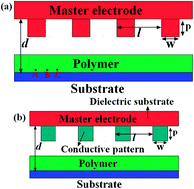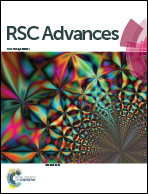Simulation of the electrohydrodynamic instability process used in the fabrication of hierarchic and hollow micro/nanostructures
Abstract
This article demonstrates that the electrohydrodynamic patterning process, a novel technique for the manufacturing of micro- and nano-scale structures, also allows the one-step realization of hierarchical structures and hollow structures. Through numerical simulation, it is shown that multilevel structures can be obtained if process time and applied electric voltage are optimized. As an example, the growth of structures with a width of around 187 nm and depth of 95 nm has been successfully simulated alongside structures with width of around 0.4 μm and depth of 0.8 μm. The width of the protrusive mask patterns is shown to determine whether hollow structures with single or multiple shapes can be formed using electric field assisted capillarity. The numerical simulation process effectively demonstrates that the realization of micro/nano-structures with hierarchic and multilevel shapes can be considered as an innovative manufacturing process for MEMS or micro/nanofluidic structures.


 Please wait while we load your content...
Please wait while we load your content...